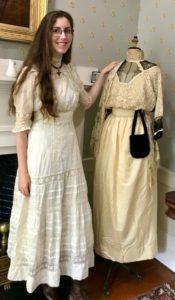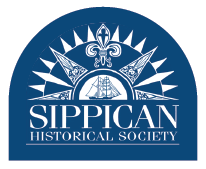 When you hear the terms “archives,” do you imagine rows of dusty shelves full of old books and papers? Perhaps the term puts you in mind of eyeglass-wearing scholars laboring over thick tomes in long rooms lit by lamps with green shades. While neither of these images is entirely fanciful, the term “archives” encompasses a broad and limitless variety of documents, objects, manuscripts, and events – anything of enduring value that tells the story of someone or something. Among the many artifacts to be found at the Sippican Historical Society are some wonderful examples of clothing from various time periods, including blouses, skirts, hats, uniforms, undergarments, shoes, children’s bonnets, and even a wedding dress. Fortunately, our collections manager, Abby Field, has a passion for fashion, and a deep interest in preserving, interpreting and even creating textiles. Here is her description of the above image:
When you hear the terms “archives,” do you imagine rows of dusty shelves full of old books and papers? Perhaps the term puts you in mind of eyeglass-wearing scholars laboring over thick tomes in long rooms lit by lamps with green shades. While neither of these images is entirely fanciful, the term “archives” encompasses a broad and limitless variety of documents, objects, manuscripts, and events – anything of enduring value that tells the story of someone or something. Among the many artifacts to be found at the Sippican Historical Society are some wonderful examples of clothing from various time periods, including blouses, skirts, hats, uniforms, undergarments, shoes, children’s bonnets, and even a wedding dress. Fortunately, our collections manager, Abby Field, has a passion for fashion, and a deep interest in preserving, interpreting and even creating textiles. Here is her description of the above image:
“Chinoiserie was very popular at the turn of the century, as several elements in this outfit demonstrate. The mannequin is dressed in a fairly typical outfit from 1910/1911, with a blouse made of chantilly and filet lace, with a yoke and collar that evoke an East Asian feel. The shawl is Western in manufacture, but the print and the silk material are a nod to the East as well. The skirt is extensively gathered at the rear and has two rows of hooks and eyes to give it shape.The skirt and belt are actually from a wedding ensemble that are just a tad earlier than the blouse. Skirt silhouettes were slow to change, however, so mixing the decades of the skirt and bodice is not terribly anachronistic. The black bag is silk and cotton velvet lined with a black-ribbed silk, and came attached to the blouse with a pin.”
This ensemble is currently on display in our Gilded Age Room, but Abby enjoys creating new looks for her mannequin (“Lillian Gish”), and rotates the outfit regularly. A student at UMass Dartmouth, Abby works at the SHS one day a week, and is usually attired in a dress, shoes and jewelry of Victorian or early 20th century vintage (original). She describes her dress (above) as “machine sewn, unlike what the mannequin is wearing. It was probably a nice dress for a working woman, much less wealthy than the one who originally wore the ensemble displayed.” Abby is always eager to talk textiles, and would be happy to share with visitors the history and provenance of her (and Lillian’s) turn-of-the-century couture, as well as that of the many other articles of clothing and footwear so carefully preserved in the SHS archives!

